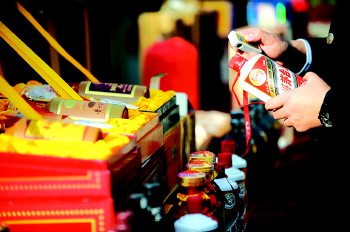
(Ecns.cn) -- When Christie's held a celebrated wine tasting event in Hong Kong recently, it smashed all the empty bottles with a hammer at the close of the evening, after getting the word that bootleggers were dousing the market with fakes by refilling the famous Chateaux empties with inferior vintages.
It was a low-tech solution for a complex problem but there are signs law enforcement is catching up with the syndicates that dominate China's massive counterfeit liquor "industry."
In 2011, China consumed a total of 1.9 billion bottles of wine, making it the world's fifth largest wine consumer, according to Vinexpo and International Wine and Spirit Research (IWSR).
Improving living standards in China and the consumer demands that go with it are driving a spike in wine consumption that has obviously created a lucrative new niche for fake products.
Last year alone police cracked 281 cases involving the production and marketing of counterfeit liquors all across the nation. In just one of the cases the tally of goods represented 3.77 million yuan (US$597,170) worth of business, according to Weekly Quality Report broadcast on China Central Television (CCTV).
Domestic brands are also targeted for counterfeiting. Maotai and Wuliangye, two famous Chinese liquors product lines, not only have bottles and packages easy to obtain or duplicate, even approximating the liquor itself is a mission well within the reach of the illicit industrial chain and its underground production and marketing operations.
Only the best
Cheng Jinsong, a senior staff member of the China National Center for Food Quality Supervision and Testing, has been studying the wine industry since 1992 and has witnessed dramatic changes in the fake wine market these past 20 years; its sophistication is growing and in the fight against counterfeit liquor products it is becoming more and more difficult for the good guys to win.
The first and most obvious challenge is reflected in the number of brands now on the market noted Cheng. Two decades ago, there were just a few wine brands in China - Sichuan Swellfun and Yanghe Blue Classic would not be on the tip of the average person's tongue, and high-end foreign brands such as Hennessy and Chateau Petrus were simply out of reach for the average consumer. Now not only are a variety of new domestic brands a permanent fixture in Chinese daily life, but so also are once rare importations.
But while the field for fakes is wide, high-end liquor brings in larger profits and so do their fake counterparts. The cunning lawbreaker will choose to counterfeit only the best. The cost to produce and promote a fake red wine comes to less than 100 yuan (US$16) per bottle, and it is easy to calculate the astronomical profit once it is passed off as a famous brand.
The phony wine industrial chain
Nevertheless the boom in the domestic wine market adds breathtaking scale to the catalogue and mechanics of counterfeiting. An unnamed insider revealed that a white wine industrial belt has already formed in a triangular area in Southwest China bounded by Chengdu, Chongqing and Guiyang; Yibin, Luzhou and Huairen are also three important bases.
Wineries in this hub usually have a full range of facilities that lend the kind of mass production capacity and economies of scale that make it profitable to churn out high-end fakes, with nothing ignored in the factory to shelf chain, including raw wine selection and ageing, labeling and packaging. The counterfeit Maotai liquor produced by organized crime in China is so close to the original even professional tasters will often fail to spot the imposter.
There are also some small-scale workshops that use raw alcohol to make fake liquor, but being too unsophisticated to reproduce authentic-looking packaging that will fool a buyer, they must disguise their vastly inferior Maotai products in genuine empty bottles, an insider revealed.
Currently the ratio of the spurious Wuliangye liquor to the genuine is about 3 to 1 in the domestic market. According to a report cited by the Shanghai Mercury, the sales volume of the 52% proof Wuliangye reached about 7 billion yuan (US$1.11 billion) in 2009, while that of its evil twin reached 20 billion yuan (US$3.17 billion) in the same year.
Turn of the corkscrew
Legitimate wine producers have fought back in different ways to protect customers from being cheated and have been very direct about the problem in their commercial promotions.
For example, Wuliangye makes announcements whenever there are packaging changes deployed or anti-counterfeiting technology updates. Currently, it uses a digital logo that contains an anti-counterfeiting code designed by Chengdu Tianxing Network Anti-counterfeiting Technology Co. Customers can easily differentiate true or fake Wuliangye liquor through the their digital anti-counterfeiting network system.
The Chinese wine market including Hong Kong, grew by 240 percent over the last five years, and the increase between 2009 and 2010 registered at 33.4 percent. As China promises to be the fastest growing market in the world over the next four years, Cheng acknowledged the government is directing more resources to crack down on the fake wine industry at the source, and before the marketing link in the chain, to improve the testing techniques that distinguish fakes from genuine wines.

Copyright ©1999-2011 Chinanews.com. All rights reserved.
Reproduction in whole or in part without permission is prohibited.